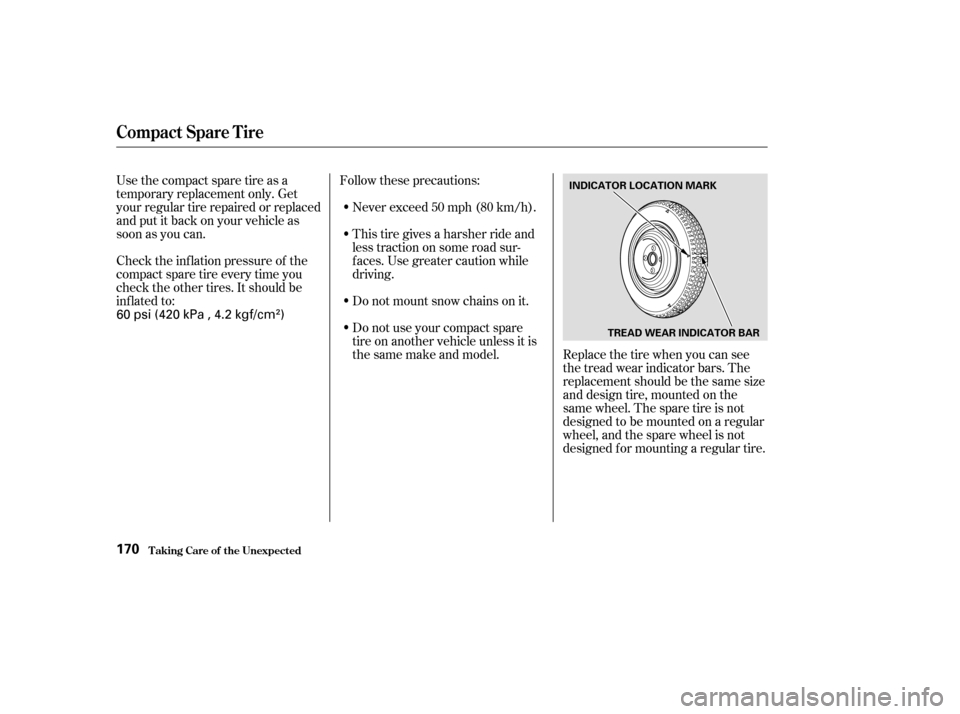Page 164 of 221

�´
Wheels:
Tires:
If you ever replace a wheel, make
sure that the wheel’s specif ications
match those of the original wheels. See page f or DOT tire quality
grading inf ormation, and page
f or tire size explanation.
Tires marked ‘‘M S’’ or ‘‘All
Season’’ on the sidewall have an all-
weather tread design suitable for
most winter driving conditions.
For the best perf ormance in snowy
or icy conditions, you should install
snow tires or tire chains. They may
be required by local laws under
certain conditions.
If you mount snow tires on your
Honda, make sure they are radial
tires of the same size and load range
as the original tires. Mount snow
tires on all f our wheels. The traction
provided by snow tires on dry roads
maybelowerthanyouroriginaltires.
Check with the tire dealer f or
maximum speed recommendations.
Replace your tires with radial tires of
the same size, load range, speed
rating and maximum cold tire
pressure rating (as shown on the
tire’s side wall).
Mixing radial and bias-ply tires on
your vehicle can reduce braking
ability, traction, and steering
accuracy. Using tires of a dif f erent
size or construction can cause the
ABS to work inconsistently.
It is best to replace all f our tires at
thesametime.If thatisnotpossible
or necessary, replace the two f ront
tires or two rear tires as a pair.
Replacing just one tire can seriously
af f ect your vehicle’s handling.
(DX)
(LX, EX and Canadian Si)
(DX)199
198
(Canadian LX)
(U.S.EX,LX,CanadianSi)
Wheel and T ire Specif ications
Replacing T ires
Winter Driving
Snow T ires
Maint enance
Tires
165
14x51/2JJ
15x6JJ
P185/70R14 87S
P185/65R15 86H
P195/60R15 88H
Installing improper tires on your
vehicle can affect handling and
stability. This can cause a crash
in which you can be seriously
hurt or killed.
Always use the size and type of
tires recommended in this
owner’s manual.
�����—�����—�����y�
�������������y���
�(�����������y���
�����y
Page 165 of 221
Because your Honda has limited tire
clearance, mount only SAE Class ‘‘S’’
cable-type traction devices, with
rubber chain tensioners on the f ront
tires. Use traction devices only when
required by driving condition or local
laws.Makesuretheyarethecorrect
size f or your tires. Metal link-type
‘‘chains’’ should not be used.
When installing cables, f ollow the
manuf acturer’s instructions, and
mount them as tight as you can.
Make sure they are not contacting
the brake lines or suspension. Drive
slowly with them installed. If you
hear them coming into contact with
the body or chassis, stop and
investigate. Remove them as soon as
you begin driving on cleared roads.
Tires
Tire Chains
Maint enance166
NOTICE:Traction devices that are the
wrong size or improperly installed can
damage your vehicle’s brake lines,
suspension, body, and wheels. Stop
driving if they are hitting any part of
the vehicle.
�����—�����—�����y�
�������������y���
�(�����������y���
�����y
Page 169 of 221

Check the inf lation pressure of the
compact spare tire every time you
check the other tires. It should be
inf lated to:Follow these precautions:
Never exceed 50 mph (80 km/h).
This tire gives a harsher ride and
less traction on some road sur-
f aces. Use greater caution while
driving.
Do not mount snow chains on it.
Use the compact spare tire as a
temporary replacement only. Get
your regular tire repaired or replaced
and put it back on your vehicle as
soon as you can.
Do not use your compact spare
tire on another vehicle unless it is
thesamemakeandmodel. Replacethetirewhenyoucanseethe tread wear indicator bars. The
replacement should be the same size
and design tire, mounted on the
same wheel. The spare tire is not
designed to be mounted on a regular
wheel, and the spare wheel is not
designed f or mounting a regular tire.
Compact Spare Tire
T aking Care of t he Unexpect ed170
INDICATOR LOCATION MARK
TREAD WEAR INDICATOR BAR
60 psi (420 kPa , 4.2 kgf/cm)
�����—�����—�����y�
������
������y���
�(�����������y���
�����y
Page 198 of 221

�µ�µ �µ �µ �µ �µ �µ �µ
�µ �µ �µ �µ
The temperature grades are A (the
highest), B, and C, representing the
tire’s resistance to the generation of
heat and its ability to dissipate heat
when tested under controlled
conditions on a specif ied indoor
laboratory test wheel. Sustained high
temperature can cause the material
of the tire to degenerate and reduce
tire life, and excessive temperature
can lead to sudden tire f ailure. The
grade C corresponds to a level of
perf ormance which all passenger
vehicle tires must meet under the
Federal Motor Vehicle Saf ety
Standard No. 109. Grades B and A
represent higher levels of
perf ormance on the laboratory test
wheel than the minimum required by
law.
Warning: The temperature grade f or
this tire is established f or a tire that
is properly inf lated and not over-
loaded. Excessive speed, underinf la-
tion, or excessive loading, either separately or in combination, can
cause heat buildup and possible tire
f ailure.
Date of manuf acture.
Tire type code.
Manuf acturer’s
identification mark.
This indicates that the tire
meets all requirements of
the U.S. Department of
Transportation.
Tire Identif ication Number (TIN) is
a group of numbers and letters that
look like the f ollowing example TIN.
Speed symbol (an
alphabetical code indicating
the maximum speed rating).
Load index (a numerical code
associated with the maximum
load the tire can carry).
Rim diameter in inches.
Tire construction code (R
indicates radial).
Whenever tires are replaced, they
should be replaced with tires of the
same size. Following is an example
tire size with an explanation of what
each component means. Aspect ratio (the tire’s section
height as a percentage of its
width).
Tire width in millimeters.
Vehicletype(Pindicates
passenger vehicle).
The tires that came on your vehicle
have a number of markings. Those
you should be aware of are described
below. P 225 55 R 16 94 V DOT B97R
FW6X 2202
Temperature A,B,C
Tire Labeling
DOT T ire Quality Grading (U.S. Vehicles), T ire L abeling
T ire Ident if icat ion Number
Tire Size
T echnical Inf ormation199
DOT B97R FW6X 2202
P225/55R 16 94V
�����—�����—�����y�
�������������y���
�(�����������y���������y